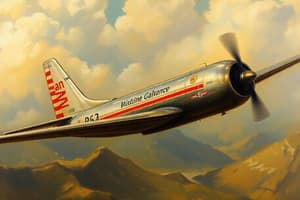Podcast
Questions and Answers
What type of conditions do PRM and ILS systems facilitate safe and efficient landing in?
What type of conditions do PRM and ILS systems facilitate safe and efficient landing in?
- Daytime conditions
- Visual meteorological conditions
- Instrument meteorological conditions (correct)
- Nighttime conditions
What are the two components of the ILS system?
What are the two components of the ILS system?
- Localizer and Glideslope (correct)
- Localizer and Radar
- Automation and Radar
- Glideslope and Automation
What is the primary function of the Localizer in the ILS system?
What is the primary function of the Localizer in the ILS system?
- Provides lateral guidance (correct)
- Tracks aircraft movement
- Analyzes radar data
- Provides vertical guidance
What is the main purpose of the PRM system?
What is the main purpose of the PRM system?
What is a key benefit of PRM and ILS systems?
What is a key benefit of PRM and ILS systems?
What can affect the effectiveness of ILS signals?
What can affect the effectiveness of ILS signals?
What is necessary to ensure the reliability and accuracy of PRM and ILS systems?
What is necessary to ensure the reliability and accuracy of PRM and ILS systems?
What is a limitation of PRM and ILS systems?
What is a limitation of PRM and ILS systems?
Flashcards are hidden until you start studying
Study Notes
PRM/ILS: Precision Approach and Landing Systems
Overview
- PRM (Parallel Runway Monitoring) and ILS (Instrument Landing System) are navigation aids used to facilitate safe and efficient aircraft landing.
- Both systems provide guidance to pilots during instrument meteorological conditions (IMC) or low visibility.
ILS (Instrument Landing System)
- A ground-based navigation aid that provides lateral and vertical guidance to aircraft during approach and landing.
- Comprises two components:
- Localizer (LOC): Provides lateral guidance, aligning the aircraft with the runway centerline.
- Glideslope (GS): Provides vertical guidance, indicating the aircraft's rate of descent.
PRM (Parallel Runway Monitoring)
- A system that allows simultaneous approaches to parallel runways, increasing airport capacity and reducing delays.
- Utilizes radar and automation to monitor and guide aircraft during approach and landing.
- Key components:
- Radar: Tracks aircraft movement and provides data to air traffic control.
- Automation: Analyzes radar data and provides warnings and instructions to pilots.
Key Benefits
- Improved safety: Enhanced navigation and guidance reduce the risk of accidents.
- Increased efficiency: PRM/ILS enable simultaneous approaches, increasing airport capacity and reducing delays.
- Reduced workload: Automated systems minimize pilot workload during approach and landing.
Challenges and Limitations
- Weather conditions: ILS signals can be affected by weather conditions, reducing system effectiveness.
- Interference: Other aircraft and electronic devices can interfere with ILS signals.
- Maintenance: Regular maintenance is required to ensure system reliability and accuracy.
PRM/ILS: Precision Approach and Landing Systems
Overview
- PRM and ILS are navigation aids that facilitate safe and efficient aircraft landing during instrument meteorological conditions (IMC) or low visibility.
ILS (Instrument Landing System)
- Provides lateral and vertical guidance to aircraft during approach and landing.
- Comprises two components: Localizer (LOC) and Glideslope (GS).
- Localizer (LOC) provides lateral guidance, aligning the aircraft with the runway centerline.
- Glideslope (GS) provides vertical guidance, indicating the aircraft's rate of descent.
PRM (Parallel Runway Monitoring)
- Allows simultaneous approaches to parallel runways, increasing airport capacity and reducing delays.
- Utilizes radar and automation to monitor and guide aircraft during approach and landing.
- Key components: Radar tracks aircraft movement and provides data to air traffic control, while Automation analyzes radar data and provides warnings and instructions to pilots.
Key Benefits
- Improved safety: Enhanced navigation and guidance reduce the risk of accidents.
- Increased efficiency: PRM/ILS enable simultaneous approaches, increasing airport capacity and reducing delays.
- Reduced workload: Automated systems minimize pilot workload during approach and landing.
Challenges and Limitations
- Weather conditions: ILS signals can be affected by weather conditions, reducing system effectiveness.
- Interference: Other aircraft and electronic devices can interfere with ILS signals.
- Maintenance: Regular maintenance is required to ensure system reliability and accuracy.
Studying That Suits You
Use AI to generate personalized quizzes and flashcards to suit your learning preferences.




